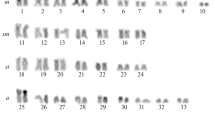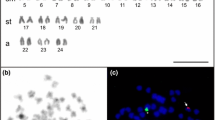Abstract
Synbranchidae belongs to the Synbranchiformes and occurs in Africa, Asia, Australia, Mexico, and Central and South America. This family comprises four genera: Synbranchus, Ophisternon, Monopterus, and Macrotrema. Only two are known from the neotropical region, Ophisternon and Synbranchus. According to current classification, Synbranchus has three valid species: S. marmoratus (Bloch 1795), S. madeirae (Rosen and Rumney 1972), and S. lampreia (Favorito, Zanata and Assumpção 2005). Thus the present research is aimed to cytogenetically characterize (by classical and molecular methods) two syntopic species—S. aff. lampreia and S. madeirae—from the central Amazon basin to validate the taxonomy of both species and provide a revisionary discussion on the cytogenetics of Synbranchiformes. Synbranchus aff. lampreia was found to possess 2n = 44 chromosomes (6 m + 2st + 36a, NF = 50), while S. madeirae had 2n = 46 chromosomes (6 m + 2st + 38a, NF = 52). Constitutive heterochromatin was dominant in the centromeric and terminal regions of most of the chromosomes in both species, although the precise distribution patterns were species-specific. The nucleolar organizing region was single in S. aff. lampreia and multiple in S. madeirae, as indicated by both AgNO3 and hybridization using 18S rDNA probes. The 5S rDNA sites were located interstitially on the long arms of an acrocentric pair in both species, and the telomeric probe did not show any interstitial sites in either species. These data indicate the occurrence of interspecific karyotypic variability in Synbranchus and suggest that taxonomic review for this genus is necessary.






Similar content being viewed by others
References
Antoneli FN (2006) Perfil morfo-funcional da inversão do sexo em Synbranchidae (Teleostei: Synbranchiformes). Ph. D Thesis, Universidade de São Paulo
Arkhipchuk VV (1999) Database of fish chromosomes. http://www.fishbase.org
Beisel C, Paro R (2011) Silencing chromatin: comparing modes and mechanisms. Nat Rev 12:123–135. doi:10.1038/nrg2932
Bertollo LAC, Takahashi CS, Moreira-Filho O (1978) Cytotaxonomic considerations on Hoplias lacerdae (Pisces, Erytrinidae). Braz J Gen 7:103–120
Bühler M (2009) RNA turnover and chromatin-dependent gene silencing. Chromosoma 118:141–151. doi:10.1007/s00412-008-0195-z
DeBaryshe PG, Pardue ML (2011) Differential maintenance of DNA sequences in telomeric and centromeric heterochromatin. Genetics 187:51–60. doi:10.1534/genetics.110.122994
Favorito SE, Zanata AM, Assumpção MI (2005) A new Synbranchus (Teleostei: Synbranchiformes: Synbranchidae) from ilha Marajó, Pará, Brazil, with notes on its reproductive biology and larval development. Neot Ichth 3:319–328. doi:10.1590/S1679-62252005000300001
Favorito-Amorim SA (1998) Relações filogenéticas da ordem Synbranchiformes e revisão sistemática da família Synbranchidae. Ph. D Thesis, Universidade de São Paulo
Favorito-Amorin SE (1992) Revisão sistemática das espécies brasileiras do gênero Synbranchus (Teleostei, Acanthopterygii). MSc Dissertation, Universidade de São Paulo
Foresti F, Oliveira C, Tien OS (1992) Cytogenetic studies in fishes of the genus Synbranchus (Pisces, Synbranchiformes, Synbranchidae). Naturalia 17:129–138
Galetti PM Jr, Aguilar CT, Molina WF (2000) An overview of marine fish cytogenetics. Hydrobiologia 420:55–62. doi:10.1023/A:1003977418900
Grewal SIS, Jia S (2007) Heterochromatin revisited. Nat Rev 8:35–46. doi:10.1038/nrg2008
Gross MC, Schneider CH, Valente GT, Martins C, Feldberg E (2010) Variability of 18S rDNA locus among Symphysodon fishes: chromosomal rearrangements. J Fish Biol 76:1117–1127. doi:10.1111/j.1095-8649.2010.02550.x
Howell WM, Black DA (1980) Controlled silver staining of nucleolus organizer regions with a protective colloidal developer: a 1-step method. Experientia 3:1014–1015. doi:10.1007/BF01953855
IJdo JW, Wells RA, Baldini A, Reeders ST (1991) Improved telomere detection using a telomere repeat probe (TTAGGG)n generated by PCR. Nucleic Acids Res 19(17):4780
Ji FY, Yu QX, Li K, Ren XH (2003) Ag-staining pattern, FISH and ISH with rDNA probes in the rice field eel (Monopterus albus Zuiew) chromosomes. Hereditas 138:207–212. doi:10.1034/j.1601-5223.2003.01643.x
Khuda-Bukhsh AR, Barat A (1987) Chromosomes in fifteen species of Indian teleosts (Pisces). Caryologia 40:131–144
Komiya H, Takemura S (1979) Nucleotide sequence of 5S ribosomal RNA from rainbow trout (Salmo gairdnerii) liver. J Bioch 86:1067–1080
Kullander SO (2003) Family Synbranchidae. In: Reis RR, Kullander SO, Ferraris CJ (eds) Check list of the freshwater of South and Central America. Editora da Universidade Católica, Porto Alegre, Brasil
Levan A, Fredga K, Sandberg AA (1964) Nomenclature for centromeric position on chromosomes. Hereditas 52:201–220
Liu JD, Yi MS, Zhao G, Zhou F, Wang DQ, Yu QX (2002) Sex chromosomes in the spiny eel (Mastacembelus aculeatus) revealed by mitotic and meiotic analysis. Cyt Gen Res 98:291–297. doi:10.1159/000071051
Lo Nostro F, Guerrero G (1996) Presence of primary and secondary males in a population of Synbranchus marmoratus, Bloch 1795, a protogynous fish (Teleostei, Synbranchiformes). J Fish Biol 49:788–800. doi:10.1111/j.1095-8649.1996.tb00079.x
Lo Nostro F, Grier H, Andreone L, Guerrero GA (2003) Involvement of the gonadal germinal epithelium during sex reversal and seasonal testicular cycling in the protogynous swamp eel, Synbranchus marmoratus Bloch 1795 (Teleostei, Synbranchidae). J Morph 257:107–126. doi:10.1002/jmor.10105
Mandrioli M, Cuoghi BC, Marini M, Manicardi GC (1999) Localization of the (TTAGGG)n telomeric repeat in the chromosomes of the pufferfish Tetraodon fluviatilis (Hamilton Buchanan) (Osteichthyes). Caryologia 52(3–4):155–157
Manna GK, Prasad R (1977) Chromosome analysis of five species of freshwater fishes. Nucleus 20:264–271
Martins C (2007) Chromosomes and repetitive DNAs: a contribution to the knowledge of fish genome. In: Pisano E, Ozouf-Costaz C, Foresti F, Kapoor BG (eds) Fish cytogenetics. Science Publisher, Inc., Enfield, pp 421–453
Martins C, Galetti PM Jr (1999) Chromosomal localization of 5S rDNA genes Schizodon (Pisces, Anostomidae) chromosomes. Chrom Res 8(4):353–355. doi:10.1023/A:1009216030316
Martins C, Galetti PM Jr (2001) Two 5S rDNA arrays in neotropical fish species: is it a general rule for fishes? Genetica 111:439–446. doi:10.1023/A:1013799516717
Martins C, Wasko AP (2004) Organization and evolution of 5S ribosomal DNA in the fish genome. In: Williams CR (ed) Focus on genome research. Nova Science Publishers, Hauppauge, pp 335–363
Melillo MIFM, Foresti F, Oliveira C (1996) Additional cytogenetic studies on local populations of Synbranchus marmoratus (Pisces, Synbranchiformes, Synbranchidae). Naturalia 21:201–208
Nelson JS (2006) Fishes of the world. Wiley, New York
Ohno S (1974) Protochordata, Cyclostomata and Pisces. In: John B (ed) Animal cytogenetics, Gebr¸der Borntraeger, p 92
Oliveira C, Almeida-Toledo LF, Foresti F, Toledo-Filho SA (1988) Supernumerary chromosomes, Robertsonian rearrangement and multiple NORs in Corydoras aeneus (Pisces, Siluriformes, Callichthyidae). Caryologia 41:227–236
Oliveira C, Torres RA, Favorito S, Foresti F (1997) Cytogenetic studies of Mastacembelus armatus (Pisces, Mastacembelidae). Cytobios 92:83–89
Pinkel D, Straume T, Gray JW (1986) Cytogenetic analysis using quantitative, high-sensitivity, fluorescence hybridization. Proc Nat Acad Sci 83:2934–2938
Ridley M (2006) Evolução. Editora Artmed, Porto Alegre, Brasil
Rosen DE, Greenwood PH (1976) A fourth Neotropical species of synbranchid eel and the phylogeny and systematics of Synbranchiform. Ann Wien von Mus Naturg 157:1–70
Rosen DE, Rumney A (1972) Evidence of a second species of Synbranchus (Pisces, Teleostei) in South America. Am Mus 2497:1–45
Ruiz-Carus R (2002) Chromosome analysis of the sexual phases of the protogynous hermaphrodites Epinephelus guttatus and Thalassoma bifasciatum (Serranidae and Labridae; Teleostei). Carib J Sci 38:44–51
Sambrook J, Russell DW (2001) Molecular cloning: a laboratory manual. Cold Spring Harbor Press, Cold Spring Harbor, pp 633–664
Sanchez S, Fenocchio AS (1996) Karyotypic analysis in three populations of the South-American eel like fish Synbranchus marmoratus. Caryologia 49:65–71
Schofield P, Nico LG (2009) Salinity of non-native Asian swamp eels (Teleostei; Synbranchidae) in Florida, USA: comparison of three populations and implications for dispersal. Environ Biol Fish 85:51–59. doi:10.1007/s10641-009-9456-9
Sumner AT (1972) A simple technique for demonstrating centromeric heterochromatin. Exp Cell Res 75:304–306. doi:10.1016/0014-4827(72)90558-7
Torres RA, Roper JJ, Foresti F, Oliveira C (2005) Surprising genomic diversity in the Neotropical fish Synbranchus marmoratus (Teleostei, Synbranchidae): how many species? Neot Ichth 3:277–284. doi:10.1590/S1679-62252005000200005
Tyler JC, Feller I (1996) Caribbean marine occurrence in the mangroves of a typically fresh water synbranchiform fish. Gulf Mex Sci 1:26–30
Yajuan L, Qixing Y (1991) Electron microscopic observation of synaptonemal complexes in spermatocytes of six species of fishes. Chin J Gen 18:273–282
Acknowledgments
This work was supported by the Instituto Nacional de Pesquisas da Amazônia (INPA) through the Research Institutional Projects, the graduate program of INPA Genética, Conservação e Biologia Evolutiva, PIPT/FAPEAM (grant number: 1749/08). Collecting was performed with a permit issued by the Brazilian Institute of the Environment and Renewable Natural Resources (IBAMA n. 10609-1/2007). NDMC was granted by Fundação de Amparo a Pesquisas do Estado do Amazonas FAPEAM. EF (process # 307536/2008-4) and JZ (process # 307464/2009-1) receive productivity grants from CNPq. This paper was reviewed by American Journal Experts.
Author information
Authors and Affiliations
Corresponding author
Rights and permissions
About this article
Cite this article
Carvalho, N.D.M., Gross, M.C., Schneider, C.H. et al. Cytogenetics of Synbranchiformes: a comparative analysis of two Synbranchus Bloch, 1795 species from the Amazon. Genetica 140, 149–158 (2012). https://doi.org/10.1007/s10709-012-9666-5
Received:
Accepted:
Published:
Issue Date:
DOI: https://doi.org/10.1007/s10709-012-9666-5




